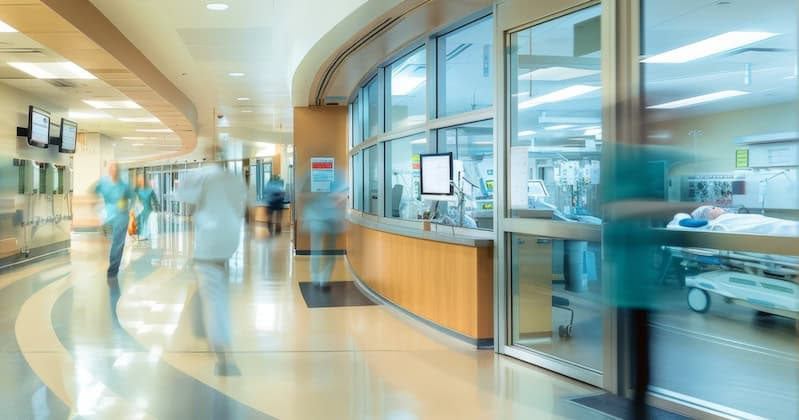The 24/7 Building: Designing Hospitals That Never Sleep

In a hospital, there are no “off-hours.” Hospitals operate as living systems, always prepared to respond, adapt, and function under any condition. Yet too often, they are designed with a 9 a.m. to 5 p.m. mindset instead of being treated as active, 24-hour hubs. Rethinking how we approach everything from infrastructure to staff support to enable true 7 a.m. to 7 a.m. operations is long overdue.
Whether it’s a night shift nurse navigating a long corridor, or a surgical team preparing for an emergency procedure, the built environment plays a central role in enabling continuous, high-quality care. To improve hospital conditions at all hours, it’s essential to turn to design and engineering as tools for resilience, clarity, and support. Flexibility, wellness, placemaking, and operational resilience are key to creating spaces that perform well at any time of day.
Care Team Wellness At All Hours
Around-the-clock care places a significant burden on healthcare workers. Fatigue, stress, and burnout are heightened in facilities that never sleep, and design can help ease these pressures. For example, intuitive layouts, clear signage, and logical wayfinding can help ease daily strain. A system that ensures critical equipment and supplies are available at all hours is essential to reduce care team frustration and prevent the moral injury that can result from delays in care caused by difficulty accessing life-saving tools.
Staff respite spaces are another critical component, essential to both clinical performance and staff retention. Quiet, restorative zones away from patient care areas, calming aesthetics, and access to nature can make a meaningful difference in how employees recover during the workday. Providing access to natural light in off-stage workrooms and respite areas can help regulate circadian rhythms and improve mental clarity for hospital staff whose duty hours include daytime.
However, some healthcare team members work overnight hours. Access to nutritious food between 8 p.m. and 6 a.m. is critical for these workers, and automated vending or attendant-less payment systems can help make that possible. Clean and well-maintained sleep rooms in quiet but easily accessible areas of the hospital, with full bathroom facilities, can support team members whose shifts may span 14 to 30 hours or who must stay for extended periods during unexpected events such as mass casualty incidents or weather emergencies.
For those who spend upwards of 80 hours a week in the hospital, often with little opportunity for rest and occasional downtime between urgent patient needs, it is important to provide access to wellness resources such as a 24/7 fitness center or recreation room, similar to those found in student housing. These amenities show respect for the physical demands and personal sacrifices required of 24/7 care teams.
In a system where staff wellness directly impacts patient outcomes, these design decisions are critical and play a key role in reducing preventable medical errors. Moreover, given the cost of replacing workers lost to burnout, investing in non-clinical, non-revenue-generating spaces to support staff wellness can have a lasting, positive impact on a health system’s bottom line.
Supporting Users Through Thoughtful Placemaking
Hospitals can be disorienting, especially during off-hours when natural cues like daylight or activity levels are minimal. Those who aren’t on staff that arrive at a hospital after hours do so because they, or someone they care about, are experiencing a medical emergency. Designing for 24/7 care means considering the cognitive needs of those who arrive late at night, under stress, and in need of clear direction. Wayfinding strategies that incorporate color and lighting can reduce confusion and help visitors navigate without additional emotional burden. This creates a safe, accessible environment for all users. Facilities that control entry points differently depending on the time of day must ensure highly visible, clearly marked, and accessible entry points to after-hours care locations. Failing to do so can result in preventable death and disability for those experiencing a medical emergency.

Placemaking within clinical settings can also reinforce a sense of calm and humanity. When communal spaces are designed with warmth and intention, they offer meaningful moments of respite for both families and staff. Thoughtfully integrated materials, lighting, and acoustics reduce the institutional feel that often defines hospital interiors, subtly supporting emotional well-being. In a 24/7 hospital, the design must balance function and feeling—recognizing comfort, clarity, and connection as equally vital to clinical efficiency.
Designing For A Continuous Future
The 24/7 building is the reality of healthcare today. Every hour, patients arrive needing care, and providers respond without hesitation. Designing for this rhythmic operation means embracing the complexity of a space that never stops moving. It requires attention to infrastructure, yes—but one attuned to the emotion, pace, and the experience of those inside.
As hospitals take on greater social and environmental significance, the need for intentional design becomes undeniable. A 24/7 hospital must be equal parts robust, responsive, and restorative. By treating the hospital as a living system—one that adapts to climate, supports its people, and responds to uncertainty—facility managers can create spaces that do more than house care; they enrich it, hour by hour, day after day.
By Heena P. Santry, MD MS MBA FACS

